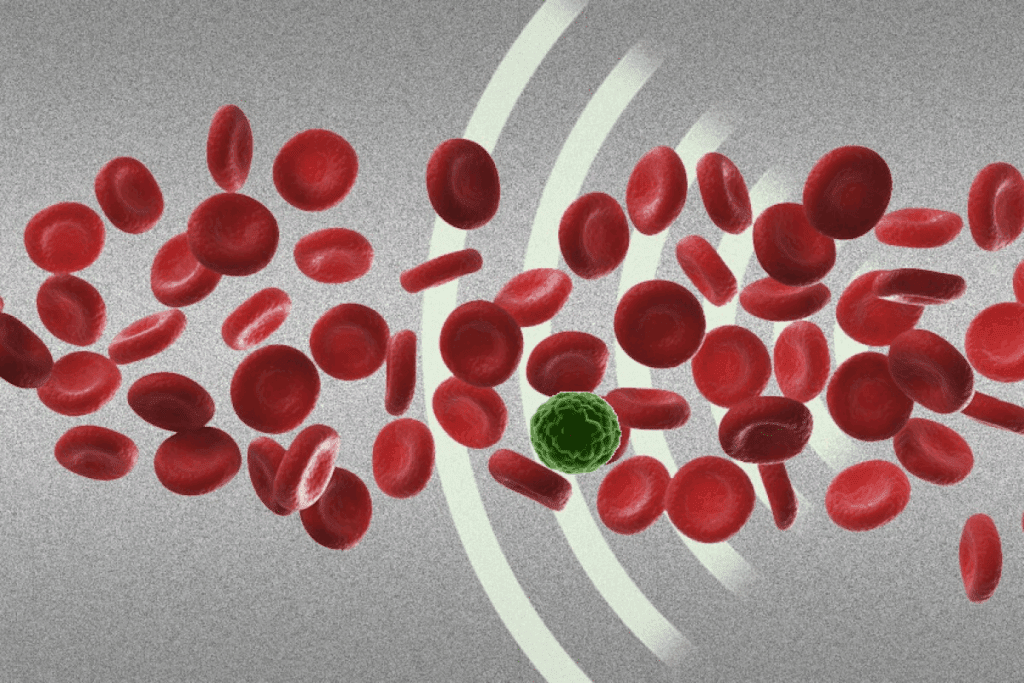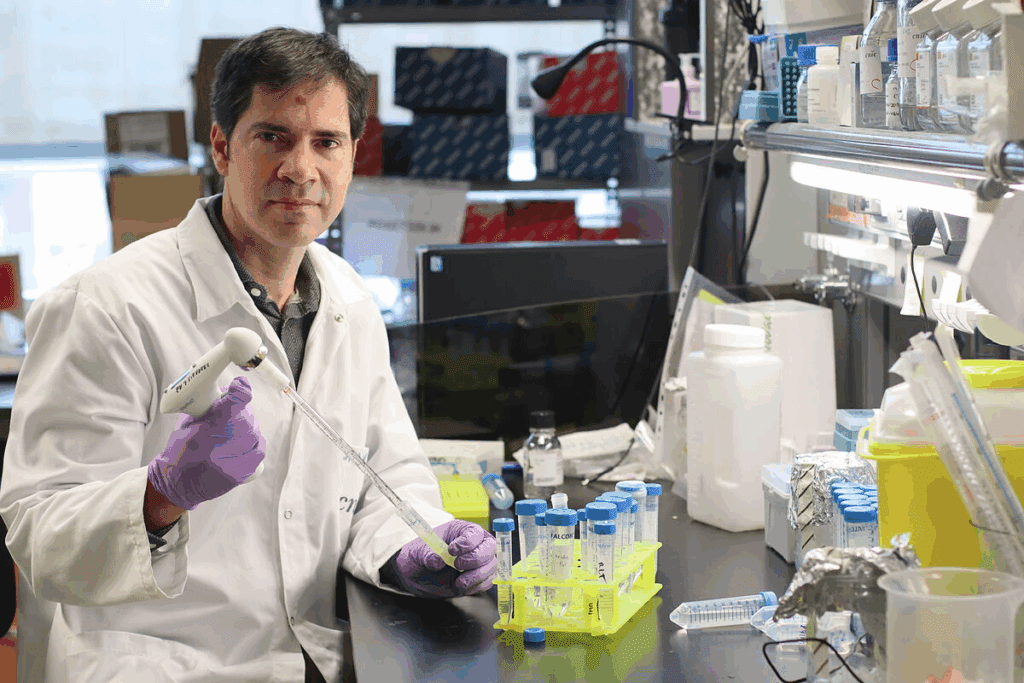Last Updated on November 26, 2025 by Bilal Hasdemir

At Liv Hospital, we focus on new and caring ways to help patients. We look into frequency healing for cancer. This method uses special electromagnetic waves to attack and kill cancer cells.
Frequency healing is getting noticed for its ability to target cancer cells. Some say frequencies between 100,000 Hz to 300,000 Hz work well. We dive into the history, science, and proof behind this therapy, including Rife machines.
Radiofrequency ablation is another treatment. It uses electrical energy and heat to kill cancer cells. It’s used for many types of cancer. We check out the claims and facts about frequency healing and Rife therapy to help our patients.
Key Takeaways
- Frequency healing uses special electromagnetic waves to target cancer cells.
- Rife machines are used in frequency healing therapy.
- Some frequencies between 100,000 Hz to 300,000 Hz are said to fight cancer cells.
- Radiofrequency ablation kills cancer cells with electrical energy and heat.
- Liv Hospital is dedicated to finding new treatments and caring for patients.
The History and Origins of Frequency Healing

The history of frequency healing is tied to Royal Raymond Rife. His research on electromagnetic frequencies and microorganisms started it all. Rife’s early 20th-century discoveries led to Rife frequency therapy or frequency healing as we know it today.
Royal Raymond Rife and His Discoveries
Royal Raymond Rife was a trailblazer in microbiology and electromagnetic therapy. He found that each microorganism has a unique electromagnetic frequency. By targeting these frequencies, he could kill harmful pathogens without harming healthy cells. His work was groundbreaking and has shaped many alternative therapies.
The Development of the Original Rife Machine
Rife created the first Rife machine. It emitted specific electromagnetic frequencies to destroy pathogens. His theory was that certain frequencies could disrupt the cells of microorganisms, making them harmless. The original Rife machine was a major leap in electromagnetic therapy.
Evolution of Frequency Therapy Through the Decades
Frequency therapy has grown a lot over the years. Modern Rife machines and other devices use advanced technology for precise frequency delivery. Today, it’s used for many health issues, including cancer treatment. Some believe specific frequencies can target cancer cells effectively.
Looking into the history of frequency healing shows Rife’s lasting impact. The field keeps evolving, but knowing its roots is key. It helps us understand both the benefits and limits of frequency therapy.
Understanding Frequency Healing Cancer: Basic Principles

Frequency healing for cancer uses special electromagnetic frequencies to interact with cells. This can potentially harm or destroy cancer cells. It’s a popular idea in alternative cancer treatments.
The Concept of Resonant Frequencies
Resonant frequencies are the specific vibrations of cells or organisms. The idea is to use these frequencies to change how cells behave. In cancer treatment, it’s thought that certain frequencies can harm or kill cancer cells. Rife treatment is based on this idea.
This concept isn’t just for cancer. It’s seen in many areas, like building design, to avoid damage. In biology, the right frequency could change how cells work.
How Electromagnetic Frequencies Interact with Cells
Electromagnetic frequencies can affect cells in different ways. The type and strength of the field matter. Cells react to various frequencies, influencing how they grow, change, and die.
For cancer, scientists look into how specific frequencies might target cancer cells. They think certain frequencies could make cancer cells die or stop growing. But his area needs more research.
Theoretical Foundations of Frequency-Based Therapies
The idea behind frequency-based therapies, like Rife therapy, is that each cell type vibrates at a unique frequency. By using this frequency, you can change how cells act. Supporters believe it can target and kill cancer cells safely.
Though the idea is interesting, the science backing it is not strong yet. More studies are needed to understand its benefits and risks.
The Science Behind Frequency Therapy for Cancer
Scientists are studying how frequency therapy can fight cancer. They look at how certain frequencies affect cancer cells. This research aims to understand how electromagnetic waves can harm cancer cells.
Frequency therapy, also known as Rife therapy, is based on a simple idea. It says every cell has a unique frequency. By finding and using the right frequency for cancer cells, it might be possible to kill them without harming healthy cells.
Cellular Resonance Theory
The cellular resonance theory is key to understanding frequency therapy. It suggests that cells react differently when exposed to their specific frequency. For cancer, the goal is to find and use the cancer cell’s frequency to stop it from growing or kill it.
Some important points of the cellular resonance theory are:
- Every cell has a unique resonant frequency.
- Using this frequency can make the cell vibrate violently, leading to its destruction.
- Frequency therapy might target cancer cells without harming healthy ones.
Proposed Mechanisms of Action
Several ways have been suggested for how frequency therapy could kill cancer cells. These include:
- Disruption of Cell Membranes: Specific frequencies might cause cancer cell membranes to break, causing cell death.
- Induction of Apoptosis: Frequency therapy could start apoptosis, or programmed cell death, in cancer cells, helping to stop tumor growth.
- Interference with Cell Division: By disrupting cell division, frequency therapy could stop cancer cells from multiplying.
While these ideas are interesting, it’s important to remember. The scientific community is ongoing in studying and discussing the effectiveness of frequency therapy for cancer treatment.
What Frequency Kills Cancer Cells? Examining the Claims
Many people are searching for the right frequency to kill cancer cells. They believe that certain frequencies can target and destroy cancer cells without harming healthy ones. This idea is based on frequency therapy, also known as Rife therapy.
Some say that frequencies between 100,000 Hz to 300,000 Hz are effective against cancer. They claim these frequencies can disrupt cancer cell function, causing them to die.
The 100,000 Hz to 300,000 Hz Range
Scientists are studying how these frequencies affect cancer cells. Some research shows that these frequencies can change cancer cell shape and make them less viable. For example, a study in the National Center for Biotechnology Information looked into how electromagnetic frequencies impact cancer cells.
Significance of the 300,000 Hz Frequency
The 300,000 Hz frequency is seen as very important in cancer treatment. Some believe it has a special ability to target cancer cells. Butthe exact way it works is not fully understood.
Specific Frequencies for Different Cancer Types
Proponents of Rife therapy think different cancers need different frequencies. For example, they say certain frequencies work better against specific tumors. But more research is needed to confirm these claims and understand which frequencies work best for each cancer type.
Cancer Healing Frequency Hz Charts and Resources
If you’re interested in frequency healing, there are many resources available. These include charts listing frequencies that are said to fight different cancers. While these resources can be helpful, it’s important to be cautious and talk to a healthcare professional before using frequency therapy as a treatment.
Rife Machine Technology and Operation
Learning about Rife machine technology is key to seeing its role in cancer treatment. Rife machines have grown a lot, thanks to new tech in electronics and medicine.
Components of Modern Rife Machines
Today’s Rife machines have important parts that work together. They make and send out healing frequencies. These parts are:
- Frequency Generators: These are the core, making a wide range of frequencies, from low (like 1 Hz) to high (like hundreds of kHz).
- Amplifiers: Some machines use amplifiers to make the signal stronger, which might help more.
- Delivery Systems: These send the frequencies to the body, like through contact electrodes or plasma tubes.
- Control Interfaces: Easy-to-use interfaces let users pick frequencies, adjust how strong they are, and check treatment details.
How Rife Machines Generate and Deliver Frequencies
Rife machines use electronic circuits and digital signal processing to make frequencies. Then, they send these frequencies to the body in different ways. Some methods are:
- Contact Electrodes: Touching the skin for focused treatment.
- Plasma Tubes: Creating a plasma field that might affect the body’s electromagnetic fields.
- Remote Application: Some devices say they can send frequencies without touching, maybe through electromagnetic fields.
This quote shows the basic idea of cancer that Rife technology is based on.
Different Types of Frequency Delivery Methods
The way frequencies are sent out can change how well Rife therapy works. There are a few ways to do this:
- Continuous Wave: Sending out a steady frequency.
- Pulsed Wave: Sending out frequencies in pulses, which might get cells to respond better.
- Sweeping Frequencies: Changing frequencies slowly to hit a range of possible resonant frequencies.
Knowing about these methods helps practitioners make Rife therapy fit each patient’s needs. This might make treatments more effective.
Clinical Research on Rife Frequency Therapy
Researchers have done many studies on Rife frequency therapy for cancer treatment. These studies help us see if it works and if it’s safe.
Laboratory Studies and Their Findings
Laboratory studies have looked at how Rife frequency therapy affects cancer cells. In vitro studies show that certain frequencies can stop cancer cells from growing and even kill them. For example, a study found that some frequencies greatly reduced cancer cell survival.
The studies suggest that Rife frequency therapy might work by damaging cancer cell membranes and messing with their processes. But we need to learn more about how it works.
In Vitro Studies on Cancer Cell Lines
In vitro studies have given us insights into Rife frequency therapy’s effects on cancer cells. Researchers have tested different frequencies on various cancer cell lines. Some studies have shown promising results, like a big drop in cancer cell growth.
For example, a study on breast cancer cells found that a specific frequency greatly reduced cell survival. This suggests Rife frequency therapy could be a helpful cancer treatment.
Animal Studies and Their Results
Animal studies have also explored Rife frequency therapy’s effects in living beings. These studies have shown that some frequencies can slow down tumor growth and improve survival in animal models. But, t’s important to remember that animal studies might not always match human results.
A study on mice with tumors found that a specific Rife frequency reduced tumor size and improved survival. These findings encourage more research into Rife frequency therapy’s benefits.
Limitations of Current Research
Even though the research on Rife frequency therapy looks promising, there are some big challenges. Many studies have small sample sizes and don’t follow the same treatment plans. We also don’t fully understand how it works with our bodies.
To move forward, we need more studies with bigger samples and strict controls. These studies will help us know for sure if Rife frequency therapy is safe and effective for cancer treatment.
Case Studies and Anecdotal Evidence
Case studies and personal stories offer insights into Rife therapy’s benefits and limits in cancer treatment. These real-life experiences help us understand how Rife therapy might work with other treatments.
Documented Cases of Cancer Treatment with Rife Therapy
Many cases show Rife therapy used in cancer treatment. Practitioners have shared stories of patients with different cancers treated with Rife therapy alone or with other treatments. These stories are valuable, even if they’re not controlled studies.
These cases highlight the variety of frequencies used for different cancers. Practitioners adjust the frequency settings based on the cancer type, stage, and patient condition. Here’s a table showing frequency ranges for different cancers:
| Cancer Type | Frequency Range (Hz) | Reported Outcomes |
| Breast Cancer | 100,000 – 200,000 | Partial remission in some cases |
| Lung Cancer | 150,000 – 250,000 | Stabilization of tumor growth |
| Prostate Cancer | 200,000 – 300,000 | Reduction in PSA levels |
Patient Testimonials and Their Context
Patient stories about Rife therapy vary. Some see big benefits, while others don’t notice much. It’s important to look at these stories in context, including the cancer type, stage, and previous treatments.
Some patients say Rife therapy improved their quality of life, reduced pain, and made them feel better overall. But these positive results might be due to many factors, like the placebo effect or the natural progression of the disease.
Evaluating Anecdotal Claims Critically
When looking at stories about Rife therapy, we need to be careful. Personal experiences are interesting, but they’re not proof of their effectiveness. We must consider individual responses, the placebo effect, and how cancer can change over time.
To really know how Rife therapy works, we need solid clinical trials. These studies can show us what Rife therapy does on its own, away from other treatments. This will give us a clearer view of its role in fighting cancer.
Mainstream Medical Perspective on Frequency Healing
Mainstream medicine is cautious about frequency healing. It looks at the good it might do and the claims that aren’t proven. We need to know what big medical groups say, the rules for using frequency devices, and the FDA’s view on Rife machines and cancer.
Position of Major Medical Organizations
Groups like the American Cancer Society and the National Cancer Institute are skeptical. They don’t think frequency healing works as a cancer cure. They say some therapies might help, but we need strong evidence to be sure.
The American Cancer Society says there’s no solid proof that frequency healing fights cancer. This shows how careful mainstream medicine is with new treatments.
Regulatory Status of Frequency Devices
How devices are regulated changes. Some get the green light from the FDA, but not for cancer. In the U.S., the FDA checks devices that use electromagnetic waves, like Rife machines, under general rules.
| Device Type | FDA Clearance | Approved for Cancer Treatment |
| Rife Machines | Cleared for marketing | No |
| Other Frequency Devices | Varies by device | No |
FDA Stance on Rife Machines and Cancer Claims
The FDA is strict with Rife machine makers. They warn companies for saying their devices can cure cancer without proof. The FDA says these claims are not backed by science.
The FDA is clear: there’s no proof Rife machines can cure cancer. This shows how important it is to base treatments on solid science.
Scientific Consensus vs. Alternative Medicine Views
The debate on frequency healing shows two different ways to see things. Mainstream medicine wants solid evidence, while some alternative practitioners rely on stories and theories.
Looking at frequency healing, we must consider both sides. We need to weigh the evidence and understand what we don’t know. This helps us understand its role in fighting cancer better.
Practical Considerations for Patients
Exploring frequency healing means looking at the practical sides. This therapy is not a replacement for medical care. It’s important to think about safety and effectiveness.
Finding Qualified Practitioners
Finding the right practitioner is key. Look for those with experience in frequency healing. They should know the technology they use.
Check their credentials and read reviews. Make sure they understand your condition and treatment options.
Questions to Ask Before Treatment
Before treatment, ask important questions. This helps you make a smart choice. Here are some questions to ask:
- What type of frequency healing technology do you use?
- What is your experience with treating my specific condition?
- What are the expected outcomes of the treatment?
- Are there any side effects or things I should avoid?
- How will you track my progress?
Cost and Insurance Considerations
The cost of frequency healing varies. It depends on the practitioner and location. It’s not usually covered by insurance, but some offer payment plans.
| Cost Component | Average Cost | Range |
| Initial Consultation | $150 | $100-$250 |
| Single Session | $100 | $75-$150 |
| Package (10 sessions) | $800 | $600-$1,000 |
Safety Concerns and Contraindications
Frequency healing is mostly safe. But there are things to watch out for. People with pacemakers should avoid it.
Tell your practitioner about any health issues or treatments you’re having. This helps avoid problems.
Knowing these practical points helps you decide if frequency healing is right for you.
Integrating Frequency Therapy with Conventional Cancer Treatments
Using frequency therapy with traditional cancer treatments might bring new hope. But, it’s importantt to think it through carefully. We need to know the good and bad sides of this mix.
Complementary Approach Considerations
When we mix frequency therapy with traditional cancer treatments, many things matter. Patient safety is the top priority. We must check if the therapy is safe with the patient’s treatment plan.
The good things about combining frequency therapy include:
- Better symptom control
- Higher quality of life
- Maybe working better with traditional treatments
But, there are also downsides to think about, like:
- Chemotherapy or radiation might not work as well
- Not all frequency therapy devices are the same
- How well it works can vary
Potential Interactions with Chemotherapy and Radiation
When we mix frequency therapy with traditional treatments, we have to watch out for interactions. We don’t know all the details, but it’s important to think about how it might change how the body reacts to treatments.
| Treatment | Potential Interaction | Consideration |
| Chemotherapy | Possible enhancement or inhibition of effects | Monitor patient response closely |
| Radiation Therapy | Potential for increased sensitivity or resistance | Adjust frequency therapy parameters as needed |
Communication with Oncology Teams
Talking well with oncology teams is key when using frequency therapy with traditional treatments. Open dialogue helps make sure everyone knows the whole treatment plan. This lowers the chance of bad reactions.
Patients should talk to their oncology team about using frequency therapy. They should share how often and for how long they use it. This helps make sure they get the best care.
Conclusion: Navigating Claims and Evidence in Frequency Healing
As we wrap up our look at frequency healing and Rife therapy, it’s vital to assess the claims and evidence. The current state of evidence for frequency healing is mixed. Some supporters make claims that lack strong clinical trial backing.
We’ve looked into the history, principles, and science of frequency therapy. We’ve also discussed its possible use alongside traditional cancer treatments. While some studies show promising results, the field needs more research. This will help us fully grasp its benefits.
It’s key for patients to carefully evaluate the claims and evidence of frequency healing. We should view this therapy with a balanced perspective. This includes recognizing both its possible advantages and its limitations. As research grows, we look forward to clearer insights into its role in cancer treatment.
FAQ
What is frequency healing for cancer?
Frequency healing for cancer uses special electromagnetic frequencies to target and kill cancer cells. It’s based on the idea that each microorganism has a unique frequency. By targeting these frequencies, it can destroy harmful pathogens without harming healthy cells.
What is a Rife machine, and how does it work?
A Rife machine is a device that sends specific electromagnetic frequencies to the body. It aims to target cancer cells and other pathogens by emitting their unique resonant frequencies. This can potentially kill them without harming healthy tissue.
What frequency range is claimed to kill cancer cells?
Some believe that frequencies between 100,000 Hz to 300,000 Hz can kill cancer cells. The 300,000 Hz frequency is often mentioned in studies and personal experiences.
Is there scientific evidence supporting the use of Rife frequency therapy for cancer?
There are some studies and animal research showing promising results. But the current evidence is not strong enough. More research is needed to fully understand Rife frequency therapy’s role in cancer treatment.
Can frequency healing be used alongside conventional cancer treatments?
Yes, frequency healing can be used with conventional treatments. Butit’s important to talk to your oncology team first. They can help ensure it’s safe and effective, considering any interactions with chemotherapy and radiation.
How do I find a qualified practitioner for frequency healing?
Look for experienced professionals in frequency healing and Rife therapy. Check their credentials and ask about their approach and experience with cancer patients.
Are Rife machines approved by regulatory agencies for cancer treatment?
The FDA hasn’t approved Rife machines for cancer treatment. While some devices may be cleared for other uses, claims about treating cancer are strictly regulated. Many Rife machines are marketed without FDA clearance for cancer treatment.
What are the possible risks or contraindications of frequency healing?
Risks include interactions with other treatments, like pacemakers or implanted devices. Some frequencies may cause discomfort or other adverse effects. Always consult with a healthcare professional before starting frequency healing.
How much does frequency healing cost, and is it covered by insurance?
The cost varies widely based on the practitioner, location, and treatment. Insurance coverage is often limited or not available. It’s important to check with your insurance provider and discuss costs with your practitioner.
Are there specific frequencies for different types of cancer?
Some believe different frequencies may be more effective for different cancers. But there’s no conclusive evidence to support specific frequency recommendations for particular cancer types.
References
- Shi, K. (2025). Precise electromagnetic modulation of the cell cycle and apoptosis for cancer therapy. Frontiers in Oncology. https://pmc.ncbi.nlm.nih.gov/articles/PMC12072891/






